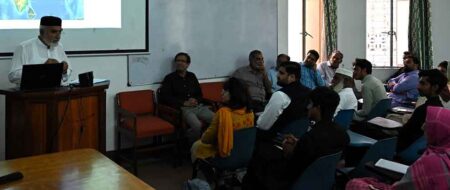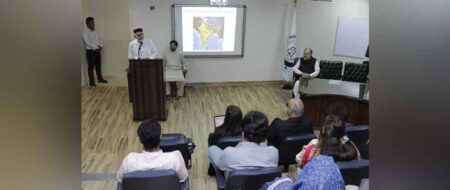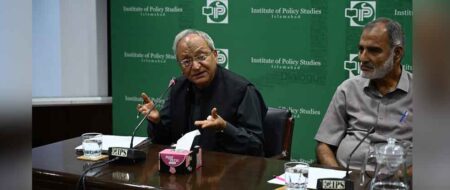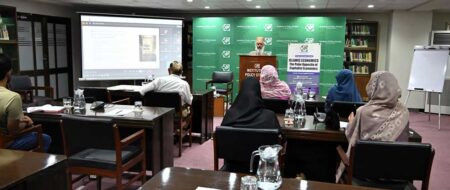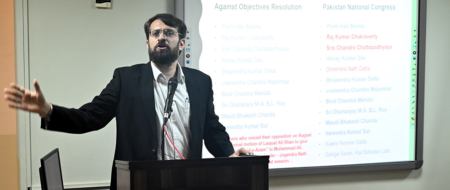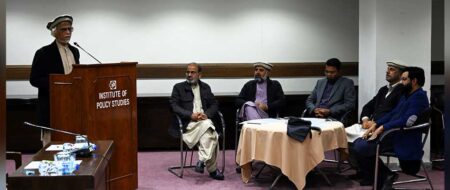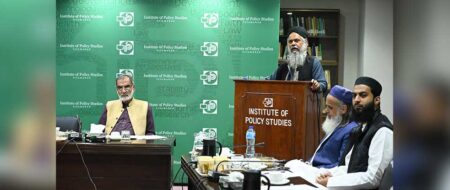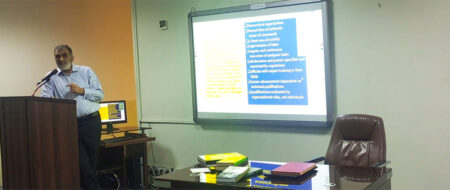A look at the history of China
The history of one of the world’s ancient civilizations was the subject of the first session of a lecture series titled “Understanding China” hosted by the Institute of Policy Studies from May 11, 2010 to May 13, 2010. Comprising of three lectures, the series sought to create greater understanding about the Chinese nation, which has sustained highly cordial relations with Pakistan from the beginning.

The history of one of the world’s ancient civilizations was the subject of the first session of a lecture series titled “Understanding China” hosted by the Institute of Policy Studies from May 11, 2010 to May 13, 2010. Comprising of three lectures, the series sought to create greater understanding about the Chinese nation, which has sustained highly cordial relations with Pakistan from the beginning.
Opening the session Director General of Institute of Policy Studies, Khalid Rahman, maintained that in the background of the enormous political and economic significance, China has assumed at the global level, and its increasing influence in the global political economy, the understanding of Chinese society, politics, and particularly the elements which led China to the stage where it has attained the position of world second largest economy, becomes inevitable. The progress China has achieved, while following the principles of co-existence, good neighborly relations and harmonious development, rather than national interest at the core of its policy orientation, renders it a good example for other nations to follow. This is particularly important for the countries like Pakistan which finds itself caught in multiple crisis.
A distinctive feature of the lecture was the participation of significant number of students, from different educational institutions, which was aimed at involving essentially the youth in such activities in order to increase their level of understanding on Chinese history, politics and society.
The guest speaker introduced the marvelous nation with the reflections of the past and successfully met the daunting challenge of describing the 4000 year’s old recorded history of China in a limited time period.
Dividing the overall history into three ages; ancient, imperial and modern, Prof. Zhou Rong started the lecture by maintaining that the word “China” has been derived from the Persian word Cin, disseminated in Europe by Marco Polo. While the official name has changed with the changing dynasties, the common name for China remains Zhongguo.
“Ancient China was one of the earliest centers of human civilization,” said Prof. Zhou Rong, while unfolding the ancient era of the Chinese history. The standardization of the Chinese language was the accomplishment of the first emperor, Qin Shi Huang, who unified the first Chinese state, the Qin state, in 221 BCE, and laid the foundation of the imperial era. The most notable dynasties in this period included; Tang dynasty, Song dynasty, Ming dynasty and Qing dynasty. Chinese technology and culture reached its zenith during Tang and Song dynasties. Besides the introduction of the first ever standing navy and paper money, the Song dynasty (960-1279 BCE) made advancements in arts and philosophy.
 The fall of the Qing dynasty (1644-1911 BCE), as a result of the European imperialism and the consequent two Opium Wars, ended the imperial era, paving the way for the establishment of Republic of China, with Kuomintang as the ruling faction, which played an instrumental role in unifying the whole Chinese nation under single rule. The one party rule by the Kuomintang was challenged by the creation of the Communist Party of China in 1921; however, the Japanese attack on Chinese mainland during World War II brought the two rivals together against the common enemy. Nevertheless, the unnatural alliance was broken away soon with the return of the defeated Japanese forces from the Chinese soil, ushering an era of Chinese Civil War, which lasted for more than three years.
The fall of the Qing dynasty (1644-1911 BCE), as a result of the European imperialism and the consequent two Opium Wars, ended the imperial era, paving the way for the establishment of Republic of China, with Kuomintang as the ruling faction, which played an instrumental role in unifying the whole Chinese nation under single rule. The one party rule by the Kuomintang was challenged by the creation of the Communist Party of China in 1921; however, the Japanese attack on Chinese mainland during World War II brought the two rivals together against the common enemy. Nevertheless, the unnatural alliance was broken away soon with the return of the defeated Japanese forces from the Chinese soil, ushering an era of Chinese Civil War, which lasted for more than three years.
The war ended up with the founding of the People’s Republic of China as a Socialist State on October 01, 1949 by the Chairman of the Communist Party, Mao Zedong, who stood victorious against the nationalist Kuomintang party with the support of millions of Chinese people. Several socio-economic reforms were introduced in China during the first generation of Communist party leadership in the decades of 1950 and 1960, which included the “Great Leap Forward”. Later with “Cultural Revolution” China saw another wave of major reforms after the demise of the first generation leadership of Communist Party. However, under the leadership of Deng Xiaoping the reforms led the nation to new heights of economic development where China entered the 21st century as an emerging economic giant. The recognition of “One China Policy” by a number of countries and intergovernmental organizations was given particular emphasis by the guest speaker while describing the modern history of China.
During the second half of the lecture, Porf. Zhou Rong shed some light on the important figures of the modern Chinese history, including; Mao Zedong, Zhou Enlai and Chiang Kai Shek, and highlighted the importance Chinese leadership, particularly Mao Zedong, gave to the Third World countries. “Confucianism was the official philosophy throughout most of China’s history, and mastery of Confucian texts was the primary criterion for entry into imperial bureaucracy”, held Prof. Zhou Rong while discussing the underlining philosophy throughout the Chinese history. He maintained that in the recent years a number of New-Confucians have advocated the compatibility of the democratic ideals and human rights notion with the traditional Confucian values.
 While responding to a question regarding the religion of China, Prof. Zhou Rong was of the view that the fundamental religion of Chinese people is Taoism. Confucianism is basically a philosophy rather than a religion, he emphasized.
While responding to a question regarding the religion of China, Prof. Zhou Rong was of the view that the fundamental religion of Chinese people is Taoism. Confucianism is basically a philosophy rather than a religion, he emphasized.
Prof. Zhou Rong also highlighted some of the notable contributions of the Chinese people to the human civilization which includes the invention of compass, paper making, silk, tea, gunpowder and porcelain. The precise figure of π (Pi) was discovered by Zu Chongzhi, who was trying to find out the ratio between circumference and diameter.
Silk Route, an important feature of Chinese history continued to provide a medium for the exchange of goods, knowledge, ideas, cultures and diseases between different parts of the world for almost 3000 years, however, its importance declined in the middle ages by the rise in the sea trade.
Pointing towards the increasing importance of Chinese medicine, Prof. Zhou Rong said that the Chinese style of treatment is gaining recognition at world level. He maintained that “the idea unifying two integral parts, man and nature, was the systematic view of the world in the traditional culture of China. Such thought allowed China to develop a set of systems that are different from western science and culture. Its characteristics lie in the ability to think systematically, comprehensively and dialectically and take an integrated view of the world.”
Reiterating the cordial relations between China and Pakistan Prof. Zhou Rong ended his lecture with these words“If we want to go to West we must go through Pakistan”.“If we want to go to West we must go through Pakistan”.
While concluding the event, chairperson Barrister Sadia Abbasi mentioned three key elements responsible for the success of Chinese nation over the past few years which includes; peace, development and harmony. She maintained that even Islam has emphasized over these elements and if Pakistani nation understands and builds upon these principles it can make such progress as has been witnessed in case of China. Harmony and balance is the core of Confucianism, reiterated the chairperson towards the end of the session.




